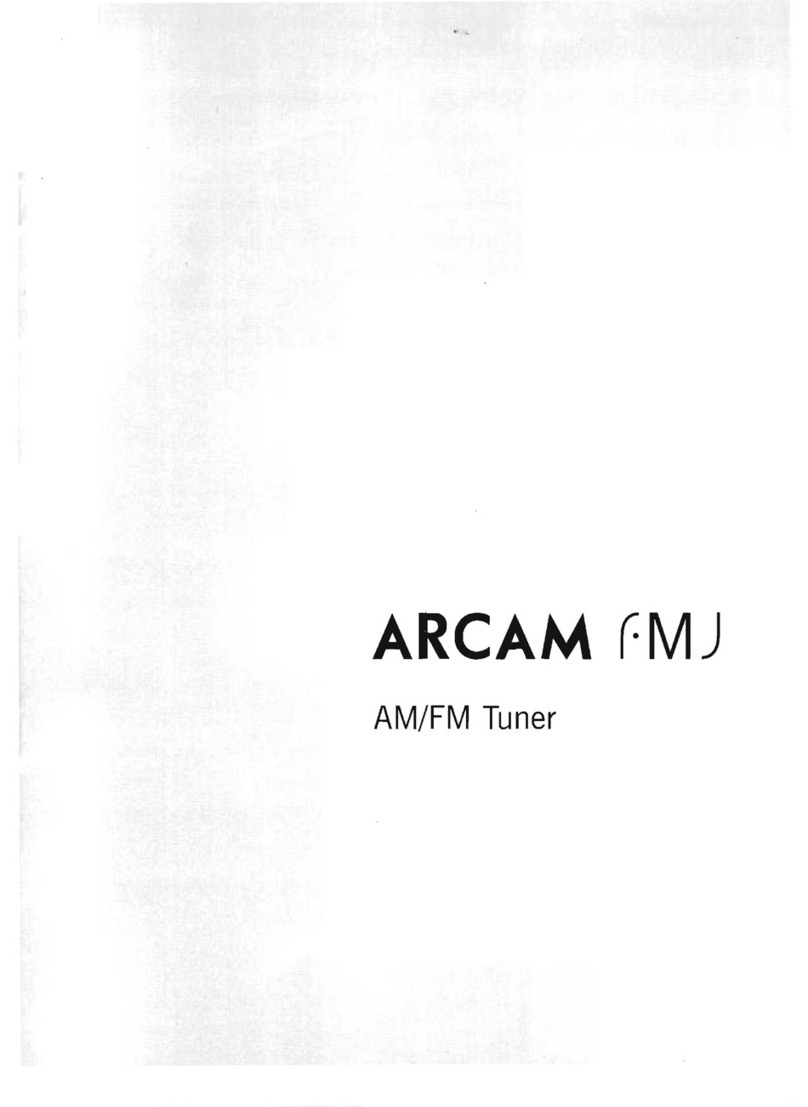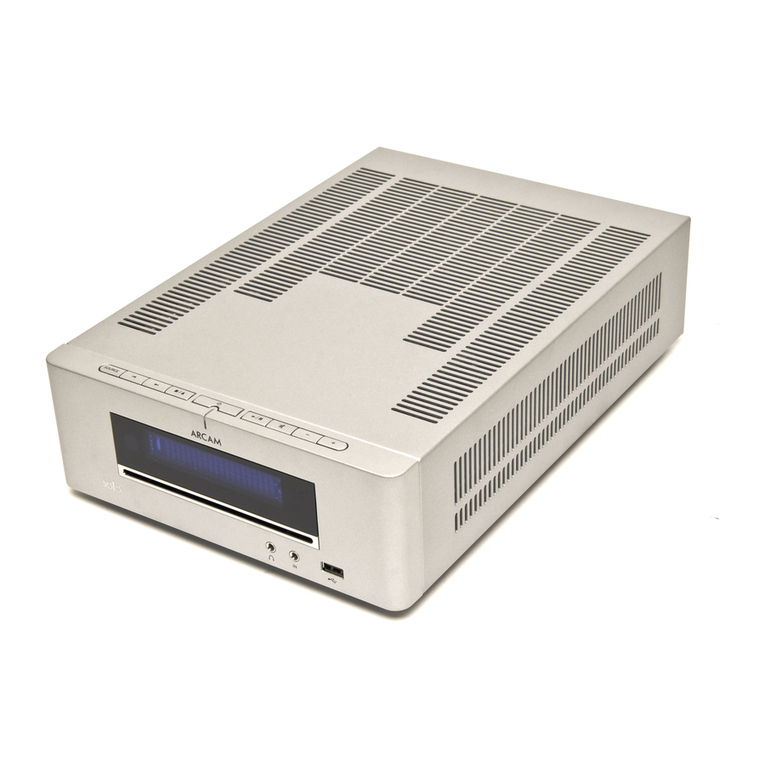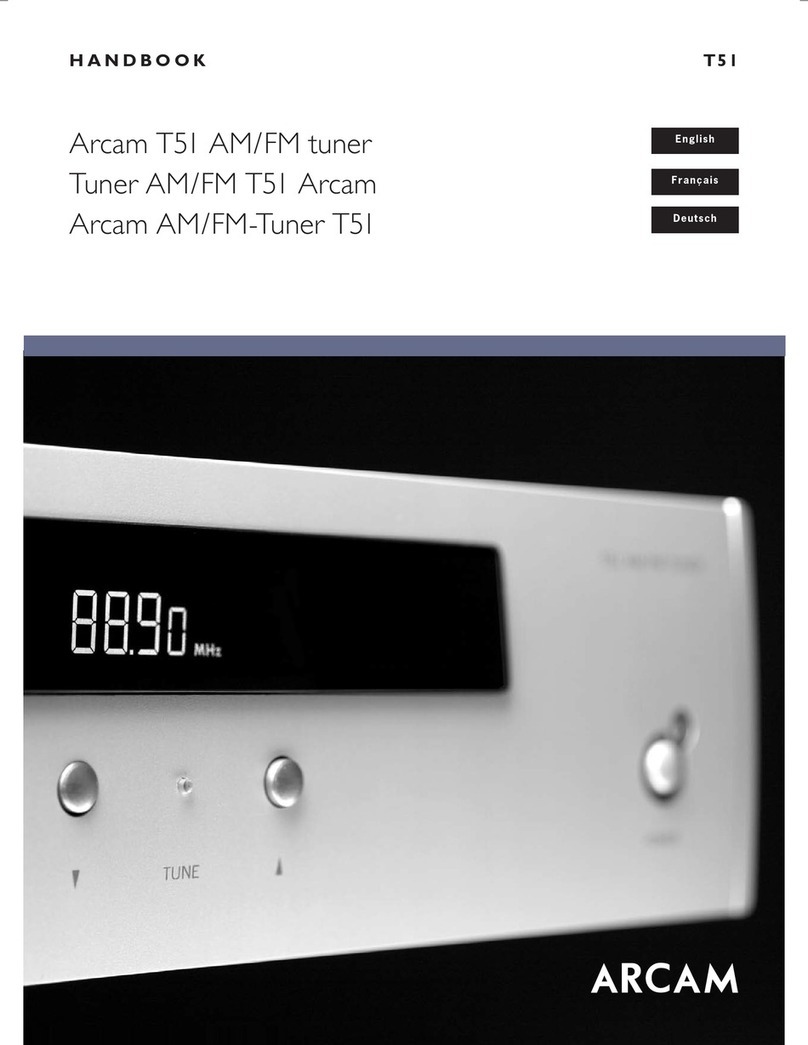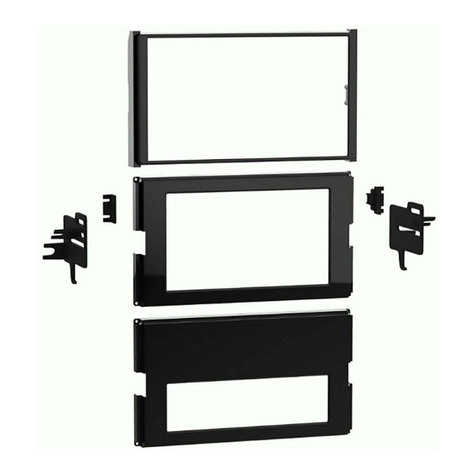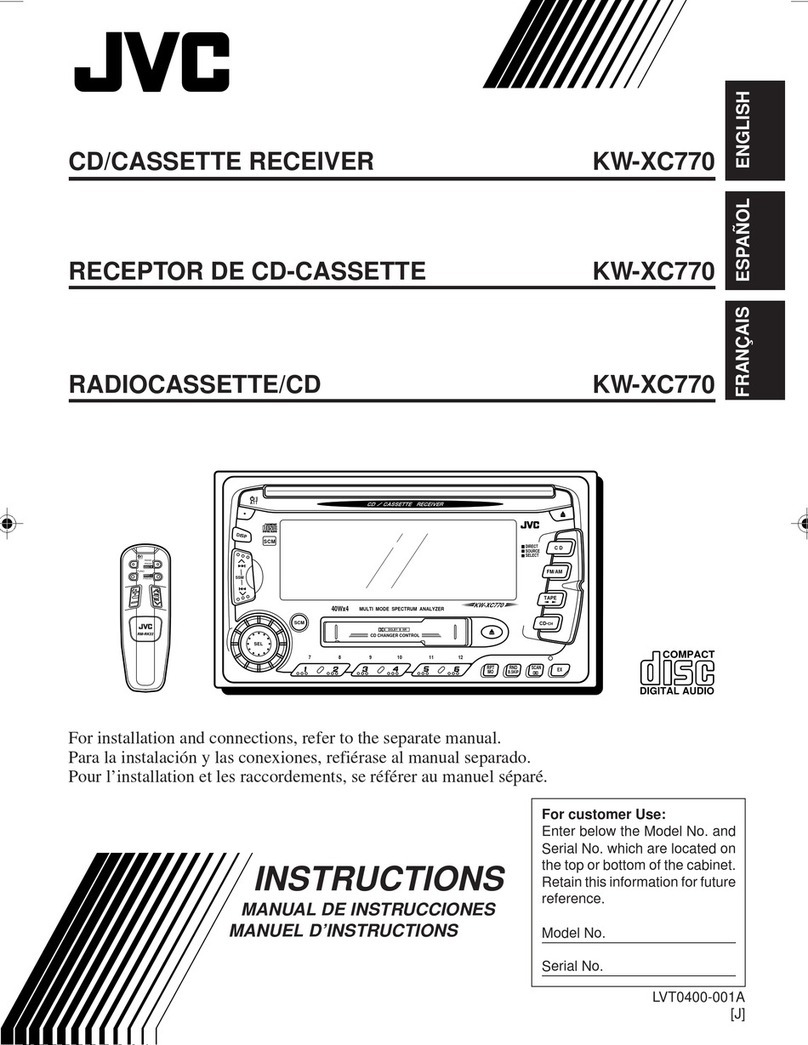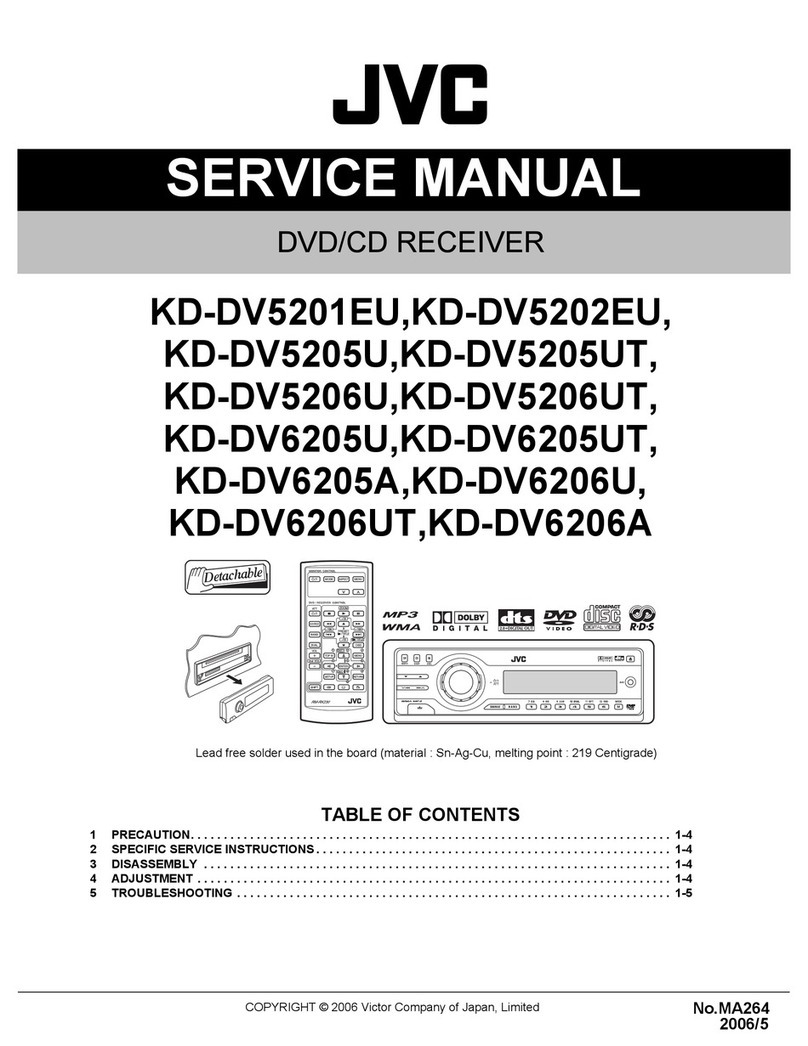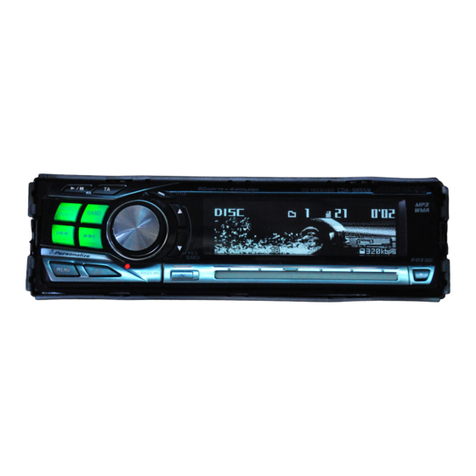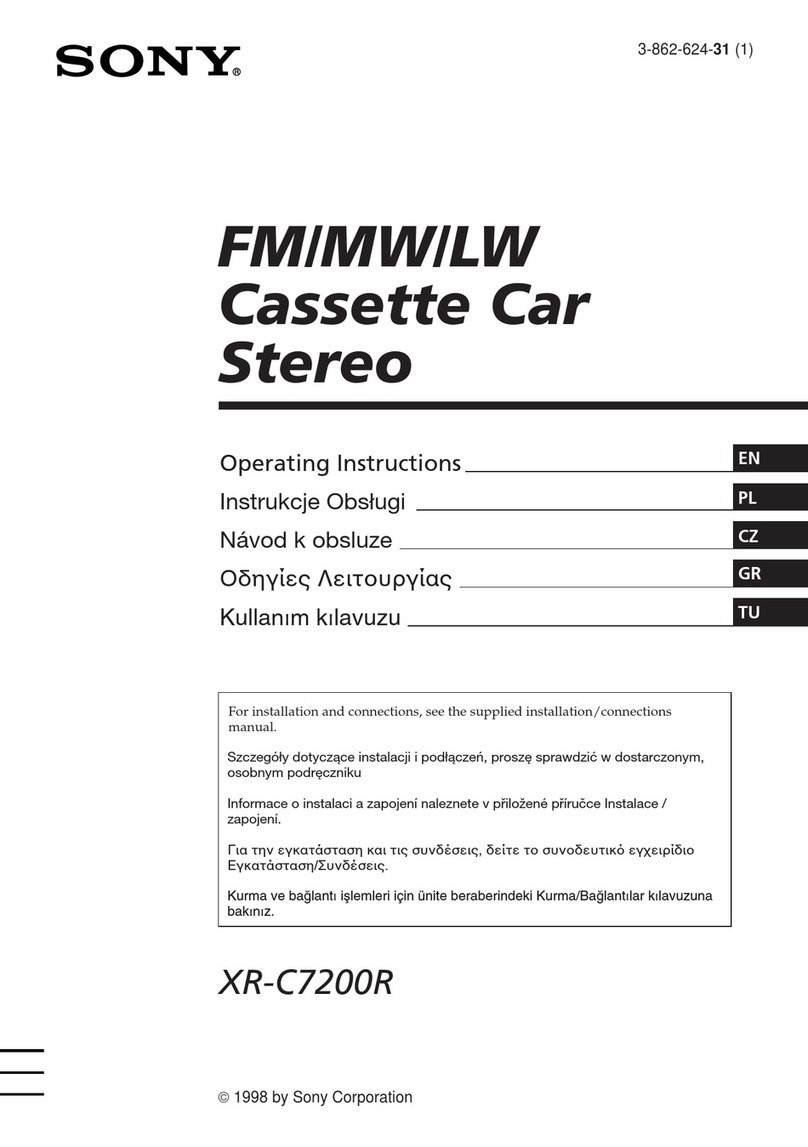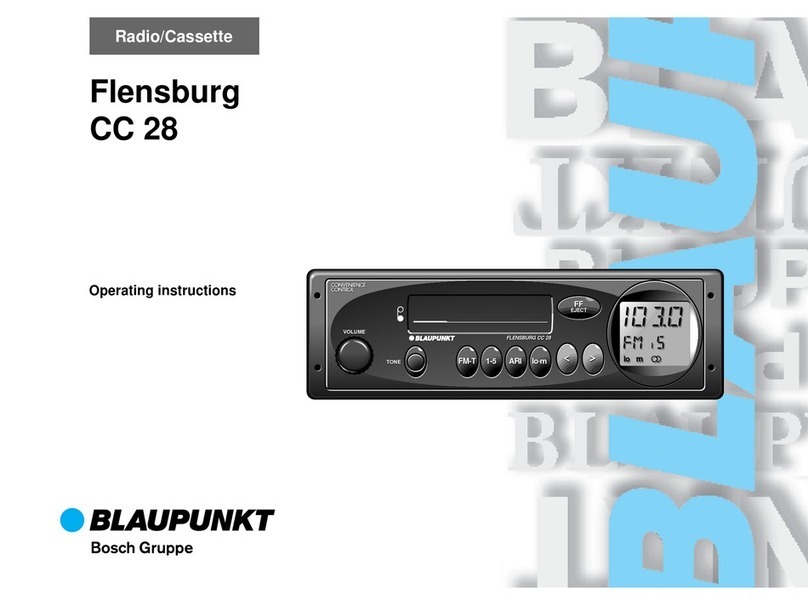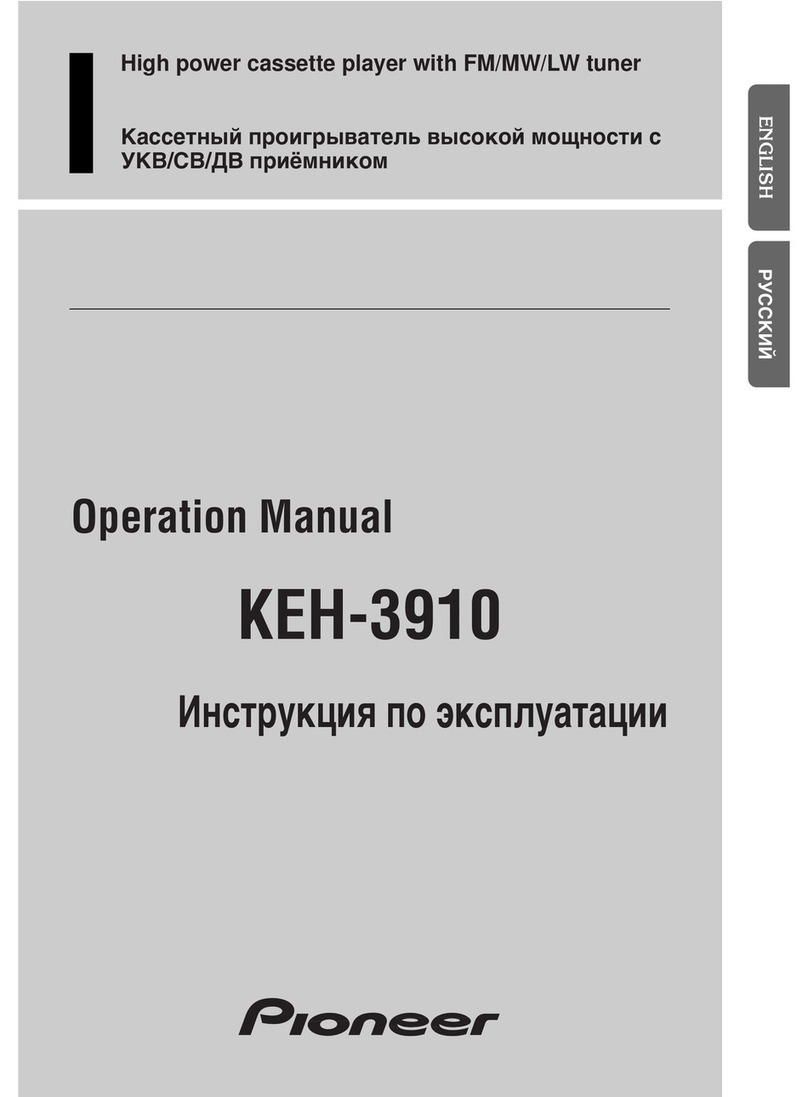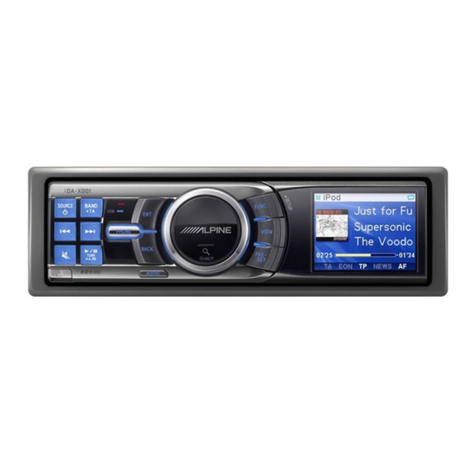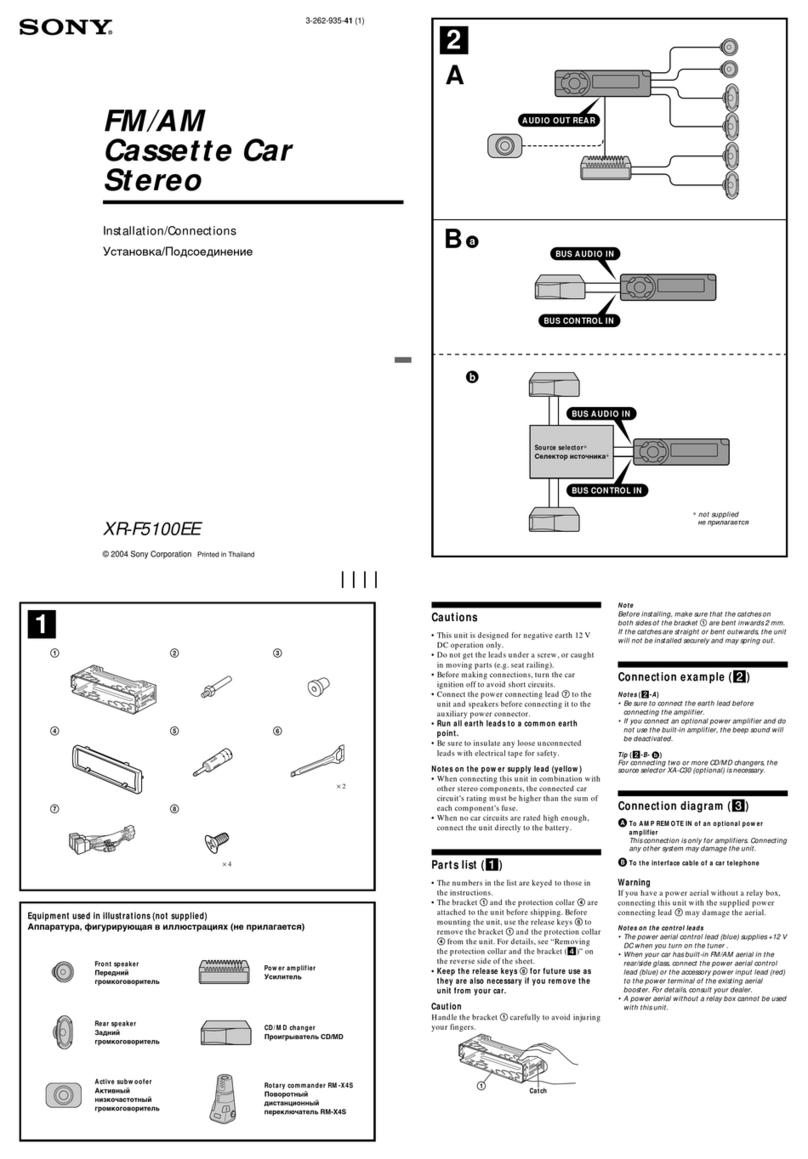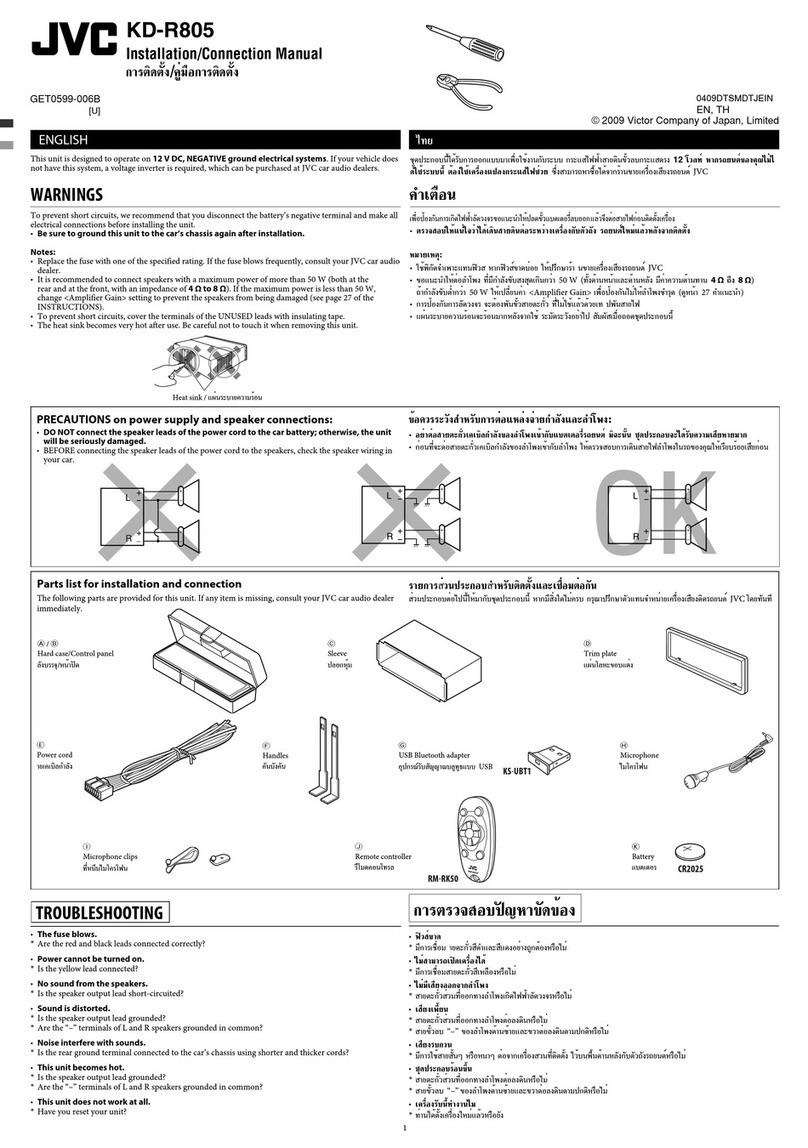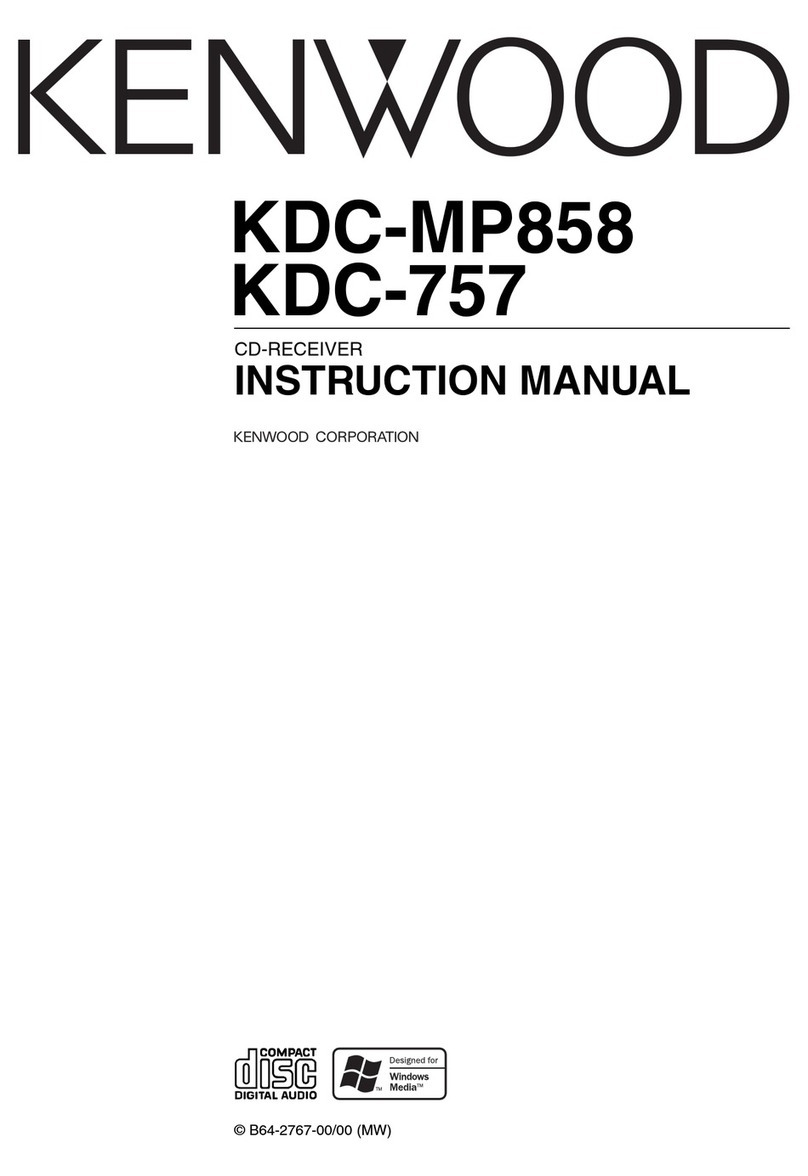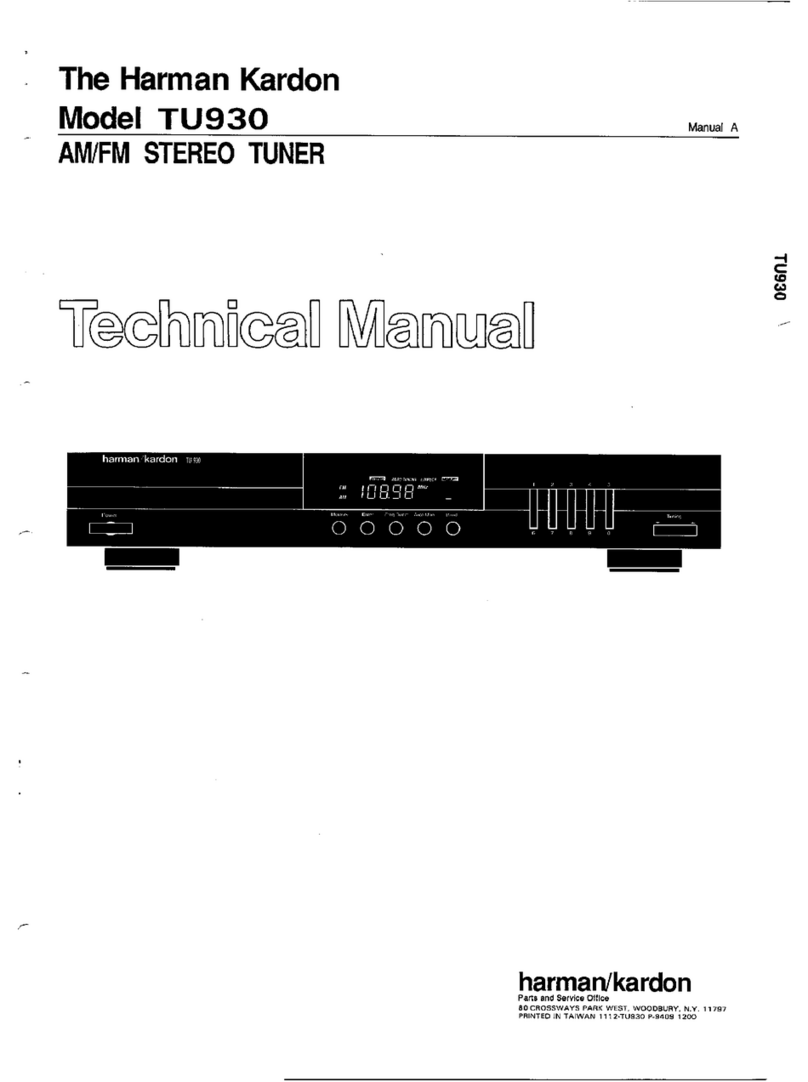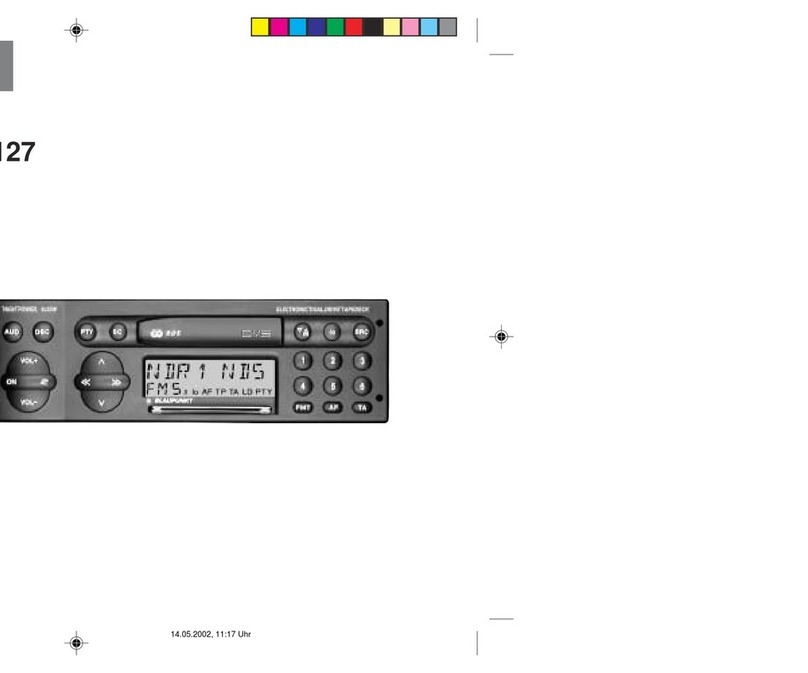Arcam T61 User manual

T61HANDBOOK
English
Français
Deutsch
Arcam T61 AM/FM tuner
Tuner FM/PO Arcam T61
Arcam AM/FM-Tuner T61

T61
2
T61
3
English
Safety guidelines
CAUTION: To reduce the risk of electric shock, do not
remove cover (or back). No user serviceable parts
inside. Refer servicing to qualied service personnel.
WARNING: To reduce the risk of re or electric shock, do
not expose this apparatus to rain or moisture.
The lightning ash with an arrowhead symbol within an equilateral
triangle, is intended to alert the user to the presence of uninsulated
‘dangerous voltage’ within the product’s enclosure that may be of
sufcient magnitude to constitute a risk of electric shock to persons.
The exclamation point within an equilateral triangle is intended to alert
the user to the presence of important operating and maintenance
(servicing) instructions in the literature accompanying the product.
CAUTION: In Canada and the USA, to prevent electric
shock, match the wide blade of the plug to the wide slot
in the socket and insert the plug fully into the socket.
Important safety instructions
This product is designed and manufactured to meet strict
quality and safety standards. However, you should be aware of
the following installation and operation precautions:
1. Take heed of warnings and instructions
You should read all the safety and operating instructions
before operating this appliance. Retain this handbook for future
reference and adhere to all warnings in the handbook or on
the appliance.
2. Water and moisture
The presence of electricity near water can be dangerous. Do
not use the appliance near water – for example next to a
bathtub, washbowl, kitchen sink, in a wet basement or near a
swimming pool, etc.
3. Object or liquid entry
Take care that objects do not fall and liquids are not spilled into
the enclosure through any openings. Liquid lled objects such
as vases should not be placed on the equipment.
4. Ventilation
Do not place the equipment on a bed, sofa, rug or similar
soft surface, or in an enclosed bookcase or cabinet, since
ventilation may be impeded. We recommend a minimum
distance of 50mm (2 inches) around the sides and top of the
appliance to provide adequate ventilation.
5. Heat
Locate the appliance away from naked ames or heat
producing equipment such as radiators, stoves or other
appliances (including other ampliers) that produce heat.
6. Climate
The appliance has been designed for use in moderate climates.
7. Racks and stands
Only use a rack or stand that is recommended for use with
audio equipment. If the equipment is on a portable rack it
should be moved with great care, to avoid overturning the
combination.
8. Cleaning
Unplug the unit from the mains supply before cleaning.
The case should normally only require a wipe with a soft, damp,
lint-free cloth. Do not use paint thinners or other chemical
solvents for cleaning.
We do not advise the use of furniture cleaning sprays or
polishes as they can cause indelible white marks if the unit is
subsequently wiped with a damp cloth.
9. Power sources
Only connect the appliance to a power supply of the type
described in the operating instructions or as marked on the
appliance.
10. Power-cord protection
Power supply cords should be routed so that they are not likely
to be walked on or pinched by items placed upon or against
them, paying particular attention to cords and plugs, and the
point where they exit from the appliance.
11. Grounding
Ensure that the grounding means of the appliance is not
defeated.
12. Power lines
Locate any outdoor antenna/aerial away from power lines.
13. Non-use periods
If the unit has a standby function, a small amount of current will
continue to ow into the equipment in this mode. Unplug the
power cord of the appliance from the outlet if left unused for
a long period of time.
14. Abnormal smell
If an abnormal smell or smoke is detected from the appliance,
turn the power off immediately and unplug the unit from the wall
outlet. Contact your dealer immediately.
15. Servicing
You should not attempt to service the appliance beyond that
described in this handbook. All other servicing should be
referred to qualied service personnel.
16. Damage requiring service
The appliance should be serviced by qualied service personnel
when:
A. the power-supply cord or the plug has been damaged, or
B. objects have fallen, or liquid has spilled into the
appliance, or
C. the appliance has been exposed to rain, or
D. the appliance does not appear to operate normally or
exhibits a marked change in performance, or
E. the appliance has been dropped or the enclosure
damaged.
Safety compliance
This product has been designed to meet the IEC 60065
international electrical safety standard.
RISQUE DE CHOC ELECTRIQUE
NE PAS OUVRIR
ATTENTION
CAUTION
RISK OF ELECTRIC
SHOCK DO NOT OPEN

T61
2
T61
3
English
Using this handbook
Contents
Safety guidelines 2
Important safety instructions 2
Safety compliance 2
Using this handbook 3
Safety 3
Information on radio transmissions 3
Installation 4
Positioning the unit 4
Setting up the tuner 4
Connecting to other equipment 5
Connecting to a power supply 5
Custom installation features 5
IR codes 5
Using your tuner 6
Front panel controls 6
Operation 6
Storing a preset 7
Deleting an unused preset 7
RDS: Radio Data System 7
Entering station names manually 7
Using the CR-389 remote control 8
Technical specications 9
Table of IR commands 10
Guarantee 11
On line registration 11
This handbook has been designed to give you all the
information you need to install, connect, set up and use the
Arcam T61 tuner. The CR-389 remote control handset supplied
with this equipment is also described.
Safety
Safety guidelines are set out on the inside front cover of this
handbook.
Many of these items are common sense precautions, but for
your own safety, and to ensure that you do not damage the unit,
we strongly recommend that you read them.
Radio interference
All Arcam products have been designed to very high standards
of electromagnetic compatibility.
However, both CD players and DVD players generate RF (radio
frequency) energy. In some cases this can cause interference
with FM and AM radio reception. If this is the case, switch the
player off or keep the player and its connecting cables as far
from the tuner and its aerials as possible. Connecting the player
and the tuner/amplier to different mains sockets can also help
to reduce interference.
EU countries
This product has been designed to comply with directive
89/336/EEC.
USA
This product complies with FCC requirements. If the equipment
causes interference to radio/television reception, which can
be determined by switching the equipment off and on, the
following measures should be taken: Re-orientate the receiving
antenna or route the antenna cable of the receiver as far
as possible from this appliance and its cabling. Relocate
the receiver with respect to this appliance. Connect the
receiver and this appliance to different mains power outlets.
If the problem persists contact your Arcam dealer or Arcam
Customer Support on +44 (0)1223 203203.
Information on radio transmissions
A free booklet (number 004-000-00345-4) is available from the
U.S. Government called ‘How to Identify and Resolve Radio-TV
Interference Problems’ by writing to:
The U.S. Government Printing Ofce
Washington, D.C.
20402.
The British Broadcasting Corporation publishes a booklet
entitled ‘Radio Transmitting Stations’ which contains details of
all BBC transmitters in the UK together with other useful hints
and tips. This booklet can be obtained on request by sending a
large stamped addressed envelope to:-
Engineers Dept.
BBC Radio
201 Wood Lane
LONDON
W12 7TS
Telephone: 08700 100 123
Internet: www.bbc.co.uk/enginfo/fm_recep
The UK Radio Authority publishes ‘The Radio Authority Pocket
Book’ which contains details of all independent radio stations.
This booklet can be obtained on request by sending a large
stamped addressed envelope to:-
Holbrook House
14 Great Queen Street
Holborn
LONDON
WC2B 5DG
Telephone: 0207 430 2724
Fax: 0207 405 7062
E-mail: info@radioauthority.org.uk
Internet: www.radioauthority.org.uk

T61
4
T61
5
English
Installation
T61 rear panel 1 Socket for IEC power inlet line
2 Voltage selector switch
3 Remote control input
4 Power On/Standby trigger in
5 AM step switch
Positioning the unit
Always place the tuner on a level, rm surface.
Setting up the tuner
AM step switch 5
The AM tuning ‘step size’ needs to be set according to your
location. This is done using the switch on the rear panel: set
it to 10kHz if you are in North America, or 9kHz anywhere
else. This switch also ensures correct reproduction of FM
broadcasts for your location.
AM aerial
An AM aerial is required to receive AM/Medium Wave radio
signals.
An external AM loop aerial is supplied as an accessory. This
should be attached to the AM Antenna inputs with one end
connected to AM 9 and the other to Ground 8. It does not
matter which way round this aerial is tted. Rotate the aerial to
discover which position gives the best reception.
In areas of weak reception or when the receiver is used inside
a steel framed building (such as an apartment building) you
can use a wire between 3 and 5 metres long to strengthen
reception. Mount this high up outside the building, if possible,
and connect one end of this wire to the AM antenna input 9
as well as the loop aerial supplied. DO NOT DISCONNECT THE
LOOP AERIAL.
1 2 3 654
L
R
AUDIO
OUTPUTS
12
AERIALS
FM 75GND AM
POWER INLET 120V 230V
7 8 9
IR IN 12V
TRIGGER
IN AM STEP
6 Audio output phono sockets, two
pairs
7 FM coaxial plug
8 Ground socket (for AM loop aerial)
9 AM socket (for AM loop aerial)
FM aerial
An FM aerial is required to receive VHF radio signals. An
external FM ribbon aerial is supplied as an accessory.
For optimal FM radio reception a roof or loft mounted aerial is
advised. For your own safety it is recommended that a roof top
aerial is tted by an experienced contractor. Your Arcam dealer
should be able to put you in contact with an aerial installer.
A contractor will be able to tune your aerial to the nearest
FM transmitter. In an apartment building an aerial system may
already be installed. If this is the case you should have sockets in
your home marked FM or VHF (do not use those marked TV).
The ‘T’ shaped wire aerial (dipole design) supplied should give
reasonably good reception. Mount this aerial as high up as
possible on a wall with the elements positioned horizontally. Try
each usable wall of the room to see which gives best reception.
Use tacks or adhesive tape to secure the aerial in a T-shape.
The tacks should not come into contact with the internal wire of
the aerial.
Whether you decide to get an aerial professionally installed or
opt to use the supplied aerial it should be connected to the FM
Antenna input 7 on the rear of the unit.
For use in North America, use an F-type antenna connector; for
Europe and other areas, use a female Belling Lee-type coaxial
connector.

T61
4
T61
5
English
Connecting to other equipment
Interconnect cables
Interconnecting cables are not supplied with this tuner. We
recommend high quality cables as inferior quality cables will
degrade the sound quality of your system. Please contact your
Arcam dealer for details of suitable cables.
Connecting your tuner to your amplier
Audio outputs 6
Two pairs of identical outputs are provided.
Connect one set to your amplier’s tuner input or any other
line-level input using suitable high quality interconnect cables.
Ensure that the left and right audio outputs from the tuner are
connected to the same left and right inputs on your amplier.
The second set of audio outputs can be used to connect to a
second amplier set up for ‘multiroom’ use, or routed to a tape
recorder for ‘off air’ recording.
Connecting to a power supply
Wrong plug?
Check that the plug supplied with the unit ts your supply and
that your mains supply voltage agrees with the voltage setting
switch (120V or 230V) indicated on the rear panel of the unit
2.
If your mains supply voltage is different, switch the voltage
selector across using a small screwdriver.
Mains lead
The appliance is normally supplied with a moulded mains plug
already tted to the lead. If for any reason the plug needs to
be removed, it must be disposed of immediately and securely,
as it is a potential shock hazard when inserted into the mains
socket. Should you require a new mains lead, contact your
Arcam dealer.
Plugging in
Push the plug (IEC line socket) of the power cable supplied with
the unit into the POWER INLET socket 1 in the back of the unit.
Make sure it is pushed in rmly.
Put the plug on the other end of the cable into your power
supply socket and switch the socket on.
Custom installation features
The T61 has a number of useful features that make it ideal for
a custom installation, where the tuner is fully integrated with
a specialist control system or operated by a programmable
remote control.
Remote control input 3
A rear panel input that receives modulated carrier-based
infrared (IR) commands in RC5 format. The input is suitable for
connection to a simple IR eye or to an external controller.
Use of this socket disables the front panel IR eye.
Trigger input 4
The trigger socket allows the tuner to be remotely switched
in and out of standby. The primary front panel POWER switch
must be in, ‘on’, for this mode.
Apply a +12V DC voltage for ‘on’, the power indicator glows
green; 0V for ‘standby’, the power indicator glows red.
Note that use of this socket requires a 12V signal before the
tuner can be switched fully on.
Infrared (IR) remote commands
The T61 responds to a set of Philips RC-5 codes in addition to
those available on the supplied handset, which is kept simple
for ease of use.
Advanced programmable control devices, such as the Philips
‘Pronto’ and other system controllers, can be set up to
use the additional codes. Refer to the instructions for your
programmable device for details.
A table of IR commands is provided on page 10 of this
Handbook.

T61
6
T61
7
English
Using your tuner
POWER
T61 AM/FM TUNER
STOREMONORDSBAND TUNING
FM
432 86 blbm1 7 9 bk5
103.50
12
PRESET
MHz
FM MUTE
STEREO
TUNED
SIGNAL
Front panel Controls
Preset Memory buttons 1
Directly select up to 32 preset stations (16 AM, 16 FM). Press
briey for stations 1–8, press and hold for more than one
second for stations 9–16.
BAND 2
Selects FM or AM frequency band. The appropriate letters
appear on the display.
RDS 3
Switches between RDS modes on FM if RDS is available. See
the section ‘RDS: Radio Data System’.
MONO 4
Selects mono or stereo output. Stereo is only available on
FM radio stations. If a weak station is received in stereo
the background hiss can be reduced (and in most cases
eliminated) by selecting ‘MONO’.
In mono mode, FM muting is suppressed when tuning between
stations and the ‘FM MUTE’ indicator is switched off.
STORE 5
The STORE button allows you to assign radio stations to preset
numbers. See the instruction ‘Storing a preset’
Preset indicator 6
Indicates the number of the preset currently selected.
Signal strength 7
A seven-step indicator shows the strength of a tuned station.
Good FM reception and locking onto RDS data generally
requires ve or more bars.
Tuning 8
Switches between Tune and Preset mode for the down/up
buttons. Preset mode is indicated by PRESET on the display.
Tune down/up 9
Used to either scroll through presets, or to tune up and down
the broadcast band, depending on the current mode. See
‘Tuning to a station’ for more details.
Frequency/ RDS display bk
Indicates the frequency of the selected station in MHz (FM) or
kHz (AM); it also displays RDS information when present.
POWER bl
Switches the mains power to the unit on or off.
Power indicator bm
This glows green to show that the unit is ready for use.
The indicator glows red in standby mode when the tuner is
switched off via the remote control, or congured in a custom
installation.
Operation
The T61 radio tuner can be controlled from the front panel
buttons or from the remote control handset (see ‘Using the
remote control’).
Tuning to a station
Pressing the TUNING button toggles between the two tuning
modes of the unit – ‘Preset’ or ‘Tune’. The selected mode is
briey shown in the display.
Preset mode
In Preset mode, press the 5 or 6 buttons on the front
panel (or < or > on the remote control handset) to cycle up and
down the preset stations.
See ‘Storing a preset’ and ‘Deleting unused presets’, below.
Tune mode
Automatic tuning:
Press the5 or 6 buttons on the front panel (or < or >
on the remote control handset) for longer than one second
to engage automatic tuning. The tuner searches for a radio
station signal of sufcient strength and stops. To skip to the
next station, press one of the buttons again. Automatic tuning
is available for both the FM and AM bands.
Manual tuning:
Tap the 5 or 6 buttons for manual tuning. This can be
used for tuning to a specic frequency. It is also useful if you
are trying to select a station that is too weak for the auto
search mode.
Regardless of the mode used to tune your T61, when it is
accurately tuned to a station ‘TUNED’ lights up in the display.

T61
6
T61
7
English
Storing a preset
To store a preset, tune to the radio station you wish to store.
Press the STORE button: this causes ‘PRESET STORE’ to ash
in the display. Now select the preset number you wish to assign
to the station using the preset memory buttons or the 5 and
6 buttons on the front panel. Press the STORE button again.
Once the preset is stored, the display reverts to show
the station name (if RDS information is transmitted) or its
frequency.
To quit the memory function without storing a preset, leave the
tuner controls untouched for ten seconds. It is also possible
to overwrite a stored station by saving another in its place.
There are thirty presets available for FM use and sixteen for
AM use.
Your presets are retained when the T61 is disconnected from
the mains supply.
Deleting an unused preset
Press the RDS and STORE buttons on the front panel, wait
about three seconds, then select the preset number you want
to delete using the 5 and 6 buttons, followed by the RDS
button.
The display briey shows ‘DELETED’ and ‘– –’ is shown in
place of the preset number. You can reactivate a deleted preset
number by storing a station in the normal way.
RDS: Radio Data System
The Arcam T61 supports RDS Programme Service and RDS
Radio Text on FM broadcasts.
When a station carrying RDS information is selected ‘RDS’ lights
up in the display and shortly afterwards the station’s RDS name
(e.g. ‘BBC R3’) is shown.
Press the RDS button to view any RDS text information (if a
station is not transmitting text information, the display briey
indicates ‘NO TEXT’ and reverts to show the station name).
Press RDS again to display the station’s frequency.
Pressing RDS a third time returns you to a display of the station
name.
If the RDS button is pressed while tuned to a non-RDS
station, the display shows ‘NO NAME’ for three seconds before
reverting to the default display.
Entering station names manually
Station names can be entered and saved for preset AM
stations, and for FM stations where RDS is not available.
Station names can be up to eight characters long.
First select the band and the preset station you wish to
name. Then press and hold the RDS button for more than two
seconds. An ‘underscore’ line should appear blinking in the
rst position of the frequency display area. Use the 5 and
6 buttons beneath the display to scroll through the available
alphabet, numbers and special characters available until you
reach your wanted letter or character. Press the TUNING button
to conrm that character. The ‘underscore’ line will then move
to the next position. Repeat this process to enter the required
name. If you want to edit a character later, use the TUNING
button to step along and select it, then use the 5 and 6
keys as before to change it. When complete, press STORE to
enter the name into the preset memory.

T61
8
T61
9
English
Using the CR-389 remote control
FM DAB
PROG DISP
RPT
MODE BAND
1–9 2–10 3–11
FM
DAB
SEL
TUNER
CR-389
CD
AMPLIFIER
VCRDVD TAPEAV
TUNERCDAUXPHONO
ENTER
SP1
SP2 DISP
MENU DISP
4–12
5–13 6–14 7–15 8–16
FM/DAB
Ensure that the FM mode is selected using
the FM/DAB toggle button. The FM LED above
the FM/DAB button is lit briey when FM is
selected.
Preset memory buttons
These buttons allow access to individual preset stations.
To select a preset press the corresponding keypad button.
For presets 9–16, press and hold the corresponding
preset button for one second. Use the Tune buttons to
access FM memory presets 17 to 30.
NOTE: Remember to install the two AAA batteries
supplied before trying to use your remote control.
Do not place anything in front of the display area on the
tuner (where the IR receiver is located), or the remote
control may not work.
Tune buttons
These buttons enable you to scroll through the
stored station selections one at a time, or to tune
up or down, depending on the Tuning mode.
BAND
This button toggles between FM and AM.
MODE (Tuning mode)
This button toggles between
PRESET and TUNE modes.
Amplier controls
These buttons offer basic control over Arcam
ampliers, such as the A65, A75 or A85.
CD player controls
These buttons offer basic control over Arcam CD
players, such as the CD62, CD72, CD82 or CD92.
MENU (RDS mode)
This button scrolls through RDS modes, when available.
DISP (Display)
This button allows you to dim or switch off the tuner display.
STANDBY
This button switches the tuner (and the amplier if
appropriate) between ‘On’ and ‘Standby’.
NOTE: DAB (Digital Audio Broadcast) refers to Arcam
DAB tuners such as model DT81.

T61
8
T61
9
English
Technical specications
T61 Tuner
FM Section
Tuning range 87.5 to 108.0MHz
Frequency steps 50kHz
Presets: total/direct access 30/16
Sensitivity (IHF) for 50dB S/N ratio typically 3µV
Alternate channel selectivity better than 60dB
Capture ratio 1.5dB
Frequency response 20Hz–15kHz ±1dB
Ultimate S/N ratio (CCIR) Mono better than –75dB
Stereo better than –70dB
Total harmonic distortion (96MHz reference, 22.5kHz deviation at 1kHz)
Mono better than 0.1%
Stereo better than 0.2%
Channel separation (1kHz) better than 40dB
Pilot tone suppression better than 60dB
Output level 700mV at 75kHz deviation
AM Section
Tuning range: 10kHz step 530 to 1710 kHz
9kHz step 531 to 1602 kHz
Presets 16
Usable sensitivity typically 30µV
IF rejection > 36dB
S/N ratio (30% mod., 50mV I/P) > 38dB
Total harmonic distortion (30% mod., 50mV I/P) < 3%
Output level 300mV at 70% modulation
Control inputs
IR remote standard Philips RC-5, 36kHz carrier
IR in signal level 4–15V pk-pk
Trigger operating voltage 9–15V DC
Trigger in polarity tip positive
General
Output impedance 220Ω
Minimum recommended load 5kΩ
Power consumption 10VA
Size W x D x H 430 x 290 x 85mm
Weight net 3.8kg
Weight packed 6.0kg
Supplied accessories FM dipole aerial
AM loop aerial
mains lead
CR-389 remote control handset and batteries
E&OE
Continual improvement policy
Arcam has a policy of continual improvement for its products.
This means that designs and specications are subject to
change without notice.
NOTE: All specication values are typical unless otherwise
stated.

T61
10
T61
11
English
Table of IR commands
Command Decimal code
Standby 17–124
On 17–123
Power toggle 17–12
AM/FM band toggle 17–50
AM band 17–52, 17–46
FM band 17–53, 17–45
Tune down (seek if >1second) 17–31
Tune up (seek if >1second) 17–30
Seek tune down 17–35
Seek tune up 17–34
RDS program 17–62
RDS text 17–63
RDS frequency 17–64
Scroll RDS mode 17–55, 17–61, 17–15
Display on 17–14
Display toggle 17–18
Stereo 17–39
Mono 17–54
Stereo/Mono toggle 17–38
Preset/tune mode toggle 17–37
Preset/tune up 17–32
Preset/tune down 17–33
Store 17–41
Mute on 17–119
Mute off 17–120
Mute toggle 17–13
Preset 1 to 8 (9 to 16 if >1second) 17–1 to 17–8
Preset 9 17–9
Preset 10 to 17 17–110 to 17–117
Preset 18 to 30 17–88 to 17–100
NOTE: The above codes are consistent with the Philips RC-5
standard.

T61
10
T61
11
English
Worldwide Guarantee
This entitles you to have the unit repaired free of charge, during
the rst two years after purchase, at any authorised Arcam
distributor provided that it was originally purchased from
an authorised Arcam dealer or distributor. The manufacturer
can take no responsibility for defects arising from accident,
misuse, abuse, wear and tear, neglect or through unauthorised
adjustment and/or repair, neither can they accept responsibility
for damage or loss occurring during transit to or from the
person claiming under the guarantee.
The warranty covers:
Parts and labour costs for two years from the purchase date.
After two years you must pay for both parts and labour costs.
The warranty does not cover transportation costs at any time.
Claims under guarantee
This equipment should be packed in the original packing
and returned to the dealer from whom it was purchased, or
failing this, directly to the Arcam distributor in the country of
residence.
It should be sent carriage prepaid by a reputable carrier -–
NOT by post. No responsibility can be accepted for the unit
whilst in transit to the dealer or distributor and customers are
therefore advised to insure the unit against loss or damage
whilst in transit.
For further details contact Arcam at:
Arcam Customer Support Department,
Pembroke Avenue, Waterbeach, CAMBRIDGE,
CB5 9PB, England
Telephone: +44 (0)1223 203203
Fax: +44 (0)1223 863384
Email: [email protected]
Problems?
If your dealer is unable to answer any query regarding this or
any other Arcam product please contact your local distributor. A
list of current distributors can be found at www.arcam.co.uk.
In the U.K., contact Arcam Customer Support on 01223
203203 or write to us at the above address and we will do our
best to help you.
Guarantee
On-line registration
You can register your Arcam product on line at:
www.arcam.co.uk/reg

T61
12
T61
13
Français
Consignes de sécurité
ATTENTION : Pour éviter tout risque de choc électrique,
ne pas enlever le couvercle (ou le panneau arrière).
Aucune intervention n’est possible pour l’utilisateur. Pour
le service, voir un personnel qualié.
AVERTISSEMENT : Pour éviter tout risque d’incendie ou
de choc électrique, ne pas exposer l’appareil à la pluie
ou à l’humidité.
Le symbole d’un éclair dans un triangle a pour objet d’avertir
l’utilisateur de la présence à l’intérieur du boîtier de l’appareil de
“tension électrique dangereuse” non-isolée et de force sufsante à
constituer un risque de choc électrique.
Le point d’exclamation dans un triangle a pour objet d’avertir
l’utilisateur de la présence de renseignements importants
concernant l’utilisation et la maintenance (le service après vente)
dans la documentation fournie avec le produit.
ATTENTION : Au Canada et aux États-Unis, pour éviter
tout risque de choc électrique, alignez la lame large de
la che secteur avec la fente large de la prise murale,
puis enfoncez la che complètement.
Conseils de sécurité importants
Cet appareil a été conçu et fabriqué conformément aux
normes de qualité et de sécurité les plus strictes. Vous devez
cependant observer les précautions suivantes lors de son
installation et de son utilisation.
1. Avertissements et consignes
Il est conseillé de lire les consignes de sécurité et d’utilisation
avant de mettre cet appareil en marche. Conservez ce
manuel pour pouvoir vous y référer par la suite et respectez
scrupuleusement les avertissements gurant dans ce manuel
ou sur l’appareil lui-même.
2. Eau et humidité
L’installation d’un appareil électrique à proximité d’une source
d’eau présente de sérieux risques. Il ne faut pas utiliser l’appareil
à proximité d’un point d’eau : près d’une baignoire, d’un lavabo,
d’un évier, dans une cave humide ou à côté d’une piscine, etc.
3. Chute d’objets ou inltration de liquides
Veillez à ne pas laisser tomber d’objets ni faire couler de
liquides à travers l’une des ouvertures du boîtier. Ne posez pas
d’objet contenant du liquide sur l’appareil.
4. Ventilation
Évitez de placer l’appareil sur un lit, un canapé, un tapis ou
une surface similaire instable, ou dans une bibliothèque ou un
meuble fermé, ce qui risquerait d’empêcher une ventilation
correcte. Pour permettre une ventilation appropriée, il est
conseillé de prévoir au minimum un espace de 5 cm de
chaque côté et au-dessus de l’appareil.
5. Exposition à la chaleur
Ne placez pas l’appareil près d’une amme nue ou d’un
dispositif produisant de la chaleur, tel un radiateur, un poêle ou
autre appareil (y compris les amplicateurs).
6. Conditions climatiques
L’appareil est conçu pour fonctionner dans des climats
modérés.
7. Étagères et supports
Utilisez uniquement des étagères ou des supports pour
appareils audio. Si l’appareil est posé sur un support mobile,
déplacez celui-ci avec précaution, pour éviter tout risque de
chute.
8. Nettoyage
Débranchez l’appareil du secteur avant de le nettoyer.
Pour le nettoyage, utilisez un chiffon doux, humide et non
pelucheux. N’utilisez pas de diluant pour peinture ou de solvant
chimique.
L’emploi d’aérosols ou de produits de nettoyage pour meubles
est déconseillé, car le passage d’un chiffon humide risquerait
de laisser des marques blanches indélébiles.
9. Alimentation secteur
Branchez l’appareil uniquement sur une alimentation secteur
du type mentionné dans le manuel d’utilisation ou indiqué sur
l’appareil lui-même.
10. Protection des cordons secteur
Veillez à ce que les cordons secteur ne se trouvent pas dans
un lieu de passage ou pincés par un objet quelconque. Prêtez
particulièrement attention aux cordons et ches secteur à leurs
points de sortie de l’appareil.
11. Mise à la terre
Assurez-vous que l’appareil est correctement mis à la terre.
12. Câbles haute tension
Évitez de monter une antenne extérieure à proximité de câbles
haute tension.
13. Périodes de non-utilisation
Si l’appareil possède une fonction de mise en veille, un courant
faible continuera de circuler lorsqu’il est réglé sur ce mode.
Débranchez le cordon secteur de la prise murale si l’appareil
doit rester inutilisé pendant une période prolongée.
14. Odeur suspecte
Arrêtez et débranchez immédiatement l’appareil en cas de
fumée ou d’odeur anormale. Contactez immédiatement votre
revendeur.
15. Service
Ne tentez pas d’effectuer d’autres opérations que celles
mentionnées dans ce manuel. Toute autre intervention doit être
effectuée par un personnel qualié.
16. Entretien par un personnel qualié
L’appareil doit être entretenu par du personnel qualié lorsque :
A. la che ou le cordon secteur a été endommagé,
B. des objets sont tombés ou du liquide a coulé dans
l’appareil,
C. l’appareil a été exposé à la pluie,
D. l’appareil ne semble pas fonctionner normalement ou
présente des altérations dans son fonctionnement,
E. l’appareil est tombé ou le boîtier a été endommagé.
Conformité aux normes de sécurité
Cet appareil est conçu pour répondre à la norme internationale
de sécurité électrique IEC 60065.
RISQUE DE CHOC ELECTRIQUE
NE PAS OUVRIR
ATTENTION
CAUTION
RISK OF ELECTRIC
SHOCK DO NOT OPEN

T61
12
T61
13
Français
Utilisation de ce manuel
Table des matières
Consignes de sécurité 12
Conseils de sécurité importants 12
Conformité aux normes de sécurité 12
Utilisation de ce manuel 13
Sécurité 13
Installation 14
Mise en place de l’appareil 14
Réglage du tuner 14
Raccordement à d’autres appareils 15
Raccordement secteur 15
Installation personnalisée 15
Codes infrarouges (IR) 15
Utilisation du tuner 16
Commandes sur la face avant 16
Emploi 16
Mémorisation d’une station 17
Suppression d’une présélection 17
RDS : Radio Data System 17
Entrée manuelle des noms de station 17
Utilisation de la télécommande CR-389 18
Spécications techniques 19
Table des commandes IR 20
Garantie 21
Enregistrement sur Internet 21
Ce manuel est conçu pour vous fournir toutes les informations
dont vous avez besoin pour installer, brancher, régler et utiliser
le tuner Arcam T61. La télécommande CR-389 fournie avec cet
appareil est aussi décrite.
Sécurité
Les consignes de sécurité gurent à la page 2 (deuxième de
couverture) de ce manuel.
Bien que bon nombre d’entre elles fassent appel au simple bon
sens, il est conseillé de les lire pour votre propre sécurité et
pour éviter d’endommager l’appareil.
Interférence radio
Tous les produits Arcam sont conçus selon des normes très
strictes de compatibilité électromagnétique.
Cependant, les lecteurs de CD et de DVD génèrent de l’énergie
à fréquence radio qui peut, dans certains cas, perturber la
réception de radio FM ou PO/GO. Si c’est le cas, éteignez le
lecteur ou éloignez autant que possible celui-ci et ses câbles
de raccordement du tuner et de ses antennes. Brancher le
cordon secteur du lecteur et celui du tuner ou de l’amplicateur
sur des prises murales différentes peut aussi aider à réduire
l’interférence.
Pays de la CE
Ce produit est conçu en conformité avec la directive 89/336/
EEC.
États-Unis
Ce produit est conforme aux normes de la FCC. Si l’appareil
perturbe la réception de radio ou de télévision, ce qui peut être
vérié en mettant l’appareil hors/sous tension, il faut prendre
les mesures suivantes. Changez l’orientation de l’antenne ou
positionnez le câble d’antenne du tuner aussi loin que possible
de cet appareil et de ses câbles de raccordement. Changez de
place le tuner par rapport à cet appareil. Branchez les cordons
secteurs du tuner et de cet appareil à des prises secteur
différentes. Si le problème persiste, contactez votre revendeur
Arcam ou le Service Clientèle Arcam au +44 (0)1223 203203.

T61
14
T61
15
Français
Installation
Panneau arrière du T61 1 Prise secteur IEC
2 Sélecteur de tension secteur
3 Entrée télécommande
4 Entrée bascule marche/veille
5 Sélecteur de pas PO
Mise en place de l’appareil
Placez toujours le tuner sur une surface plane et stable.
Réglage du tuner
Sélecteur de pas PO 5
Il faut sélectionner le pas du réglage de la fréquence PO
compatible avec les émetteurs de votre région. Au moyen du
commutateur sur le panneau arrière, réglez le pas à 10 kHz
si vous êtes en Amérique du nord, à 9 kHz partout ailleurs.
Ce commutateur assure aussi la reproduction correcte des
émissions FM dans votre région.
Antenne PO
Pour la réception de signaux radio PO, une antenne adéquate
est nécessaire.
Une antenne boucle PO externe est fournie comme accessoire.
Il faut la xer aux entrées antenne PO, une extrémité
connectée à la prise PO 9 et l’autre à la prise de terre
8. Le sens du branchement est sans importance. Tournez
l’antenne pour obtenir la meilleure réception possible.
Si la réception est faible ou si le tuner est utilisé à l’intérieur
d’un bâtiment à structure métallique (un immeuble, par
exemple), vous pouvez utiliser un l long de 3 à 5 mètres
pour améliorer la réception. Il faut installer ce l le plus haut
possible à l’extérieur du bâtiment et connecter une des
extrémités à la prise antenne PO 9. NE DÉBRANCHEZ PAS
L’ANTENNE BOUCLE.
1 2 3 654
L
R
AUDIO
OUTPUTS
12
AERIALS
FM 75GND AM
POWER INLET 120V 230V
7 8 9
IR IN 12V
TRIGGER
IN AM STEP
6 Prises de sortie audio, deux paires
7 Fiche coaxiale FM
8 Prise de terre (pour antenne boucle PO)
9 Prise PO (pour antenne boucle PO)
Antenne FM
Pour la réception des signaux radio FM, une antenne adéquate
est nécessaire. Une antenne FM externe est fournie comme
accessoire.
Pour une réception FM optimale, il est conseillé d’installer une
antenne sur le toit ou dans le grenier. Pour votre sécurité, faites
appel à un installateur professionnel. Votre revendeur Arcam
peut vous en indiquer un. L’installateur réglera votre antenne
sur l’émetteur FM le plus proche. Dans certains immeubles une
antenne est déjà installée. Dans ce cas, il y aura chez vous des
prises antenne marquées FM ou VHF (ne pas utiliser une prise
marquée TV).
L’antenne en forme de “T” fournie devrait donner d’assez
bons résultats. Installez celle-ci aussi haut que possible et
positionnez les deux éléments à l’horizontal. Pour obtenir la
meilleure réception, essayez l’antenne sur chaque mur de
la pièce où il est possible de l’installer. Fixez-la au moyen de
punaises ou de bande adhésive an de préserver sa forme
en “T”. Évitez que les punaises touchent les conducteurs de
l’antenne.
Quel que soit le type d’antenne choisie, il faut la connecter à
l’entrée antenne FM 7 sur le panneau arrière de l’appareil.
En Amérique du nord, utilisez un connecteur d’antenne type F
; en Europe et ailleurs, utilisez un connecteur coaxial femelle
type Belling-Lee.

T61
14
T61
15
Français
Raccordement à d’autres appareils
Câbles de raccordement
Les câbles de raccordement ne sont pas fournis avec ce tuner.
Nous recommandons l’utilisation de câbles de raccordement
de qualité an de ne pas nuire à la qualité sonore de votre
système. Veuillez contacter votre revendeur Arcam pour en
savoir plus.
Raccordement du tuner à l’amplicateur
Sorties audio 6
Il y a deux paires de prises de sortie identiques.
Utilisez des câbles de raccordement de qualité pour relier une
de ces paires à l’entrée tuner de l’amplicateur ou à toute autre
entrée de niveau ligne. Assurez-vous que les sorties gauche et
droite du tuner sont bien reliées aux entrées gauche et droite
de l’amplicateur.
La deuxième paire de sorties audio permet le raccordement à
un deuxième amplicateur dans un système “multi-room” ou à
un magnétophone pour l’enregistrement des émissions radio.
Raccordement secteur
La che secteur est-elle la bonne ?
Assurez-vous que la che fournie avec l’appareil correspond
à votre prise murale et que la tension secteur correspond au
réglage (120 V ou 230 V) indiqué sur le panneau arrière de
l’appareil 2.
Si votre tension secteur est différente, changez la position du
sélecteur de tension à l’aide d’un petit tournevis.
Cordon secteur
Normalement, l’appareil est livré avec une che secteur
moulée montée sur le cordon. Si vous devez, pour une raison
quelconque, retirer la che, jetez-la immédiatement car son
branchement sur une prise murale risquerait de provoquer
une électrocution. Si vous avez besoin d’un nouveau cordon
secteur, contactez votre revendeur Arcam.
Branchement
Enfoncez la che (prise IEC) du cordon secteur fourni dans la
prise secteur 1 située à l’arrière de l’appareil. Vériez qu’elle
est enfoncée complètement.
Introduisez la che située à l’autre extrémité du cordon dans
votre prise murale.
Installation personnalisée
Le T61 possède plusieurs fonctions qui facilitent son utilisation
au sein d’une installation personnalisée où le tuner est
commandé par un système de contrôle spécique ou par une
télécommande programmable.
Entrée télécommande 3
Cette entrée sur le panneau arrière peut recevoir des
commandes infrarouges (IR) sur porteuse modulée au standard
RC5. Elle peut être reliée à un simple capteur IR ou à un
système de commande externe.
L’utilisation de cette entrée met hors circuit le capteur IR sur la
face avant.
Entrée bascule 4
Cette entrée permet de télécommander la mise en marche/en
veille du tuner. Pour qu’elle fonctionne, la touche POWER sur la
face avant doit être en position “marche” (enfoncée).
La présence d’une tension de +12 V CC met le tuner en
marche et le témoin vert s’allume. Un signal de 0 V met le
tuner en veille et le témoin passe au rouge.
Notez que l’utilisation de cette entrée exige la présence d’un
signal de 12 V pour que le tuner puisse être mis en marche.
Commandes à distance infrarouges (IR)
En plus des codes générés par la télécommande fournie,
conçue pour une utilisation simple et facile, le T61 reconnaît
des codes Philips RC-5.
Les télécommandes programmables, telles le “Pronto” de
Philips et d’autres systèmes de commande, peuvent être
réglées pour l’utilisation de codes additionnels. Pour plus de
détails, consultez le mode d’emploi de votre télécommande
programmable.
Une table de commandes IR se trouve page 20 de ce manuel.

T61
16
T61
17
Français
Utilisation du tuner
POWER
T61 AM/FM TUNER
STOREMONORDSBAND TUNING
FM
432 86 blbm1 7 9 bk5
103.50
12
PRESET
MHz
FM MUTE
STEREO
TUNED
SIGNAL
Commandes sur la face avant
Touches mémoires de présélection 1
Sélectionnent directement jusqu’à 32 stations mémorisées (16
FM, 16 PO). Appuyez brièvement pour les stations 1–8 ; pour
les stations 9–16, appuyez plus d’une seconde.
BAND 2
Sélectionne la gamme FM ou PO. La gamme choisie s’afche.
RDS 3
Commute entre les modes RDS en FM, si le RDS est
disponible. Voir “RDS : Radio Data System”.
MONO 4
Sélectionne la sortie mono ou stéréo. La stéréo n’est
disponible qu’avec des stations FM. Pour réduire (et, dans la
plupart des cas, éliminer) le bruit de fond présent avec une
station stéréo faible, sélectionnez “MONO”.
En mode mono, le muting FM est supprimé entre les stations
pendant la recherche, et l’indicateur “FM MUTE” est éteint.
STORE 5
Cette touche permet d’affecter un numéro de présélection à
une station. Voir “Mémorisation d’une présélection”.
Indicateur de présélection 6
Afche le numéro de la présélection choisie.
Niveau de signal 7
Un indicateur à sept barres montre le niveau de signal de la
station captée. En FM, il faut normalement cinq barres ou plus
pour une bonne réception et pour recevoir les données RDS.
TUNING 8
Commute le mode de fonctionnement des touches haut/bas
entre Recherche et Présélection. En mode Présélection,
“PRESET” s’afche.
Recherche vers le haut/vers le bas 9
Servent, en fonction du mode choisi, à faire déler les
présélections ou à rechercher une fréquence. Voir “Recherche
d’une station”.
Afchage fréquence / RDS bk
Indique la fréquence de la station sélectionnée en MHz (FM) ou
en kHz (PO). Afche aussi les données RDS, lorsqu’elles sont
présentes.
POWER bl
Permet de mettre l’appareil sous/hors tension.
Témoin d’alimentation bm
Celui-ci est vert lorsque l’appareil est prêt à fonctionner. Il est
rouge lorsque le tuner est en veille (arrêté au moyen de la
télécommande) ou utilisé dans une installation personnalisée.
Emploi
On peut utiliser le tuner T61 en se servant des touches sur
la face avant ou de la télécommande (voir “Utilisation de la
télécommande”).
Recherche d’une station
Appuyez sur la touche TUNING pour commuter entre les deux
modes de recherche de l’appareil, Présélection et Recherche.
Le mode sélectionné s’afche brièvement.
Mode Présélection
En mode Présélection, appuyez sur les touches 5 et 6sur
la face avant (ou sur < ou > sur la télécommande) pour passer
d’une présélection à une autre.
Voir “Mémorisation d’une station” et “Suppression d’une
présélection” ci-dessous.
Mode Recherche
Recherche automatique :
Pour déclencher la recherche automatique, appuyez sur les
touches 5 et 6sur la face avant (ou sur < ou > sur la
télécommande) plus d’une seconde. Le tuner recherche un
signal de station sufsamment fort et s’arrête. Pour passer à la
station suivante, appuyez de nouveau sur une de ces touches.
La recherche automatique fonctionne sur les deux gammes FM
et PO.
Recherche manuelle :
Pour rechercher une fréquence manuellement, appuyez sur
les touches 5 et 6. On peut ainsi obtenir une fréquence
donnée, ce qui est utile en particulier pour sélectionner
une station trop faible pour être détectée par la recherche
automatique.
Avec l’un ou l’autre mode de recherche, quand le T61 est réglé
sur une station de façon précise, l’indicateur “TUNED” s’afche.

T61
16
T61
17
Français
Mémorisation d’une station
Pour mémoriser une station, réglez le tuner sur la station en
question. Appuyez sur la touche STORE : “PRESET STORE”
clignote sur l’afchage. Ensuite, au moyen des touches
mémoires de présélection ou des touches 5 et 6 sur la
face avant, sélectionnez le numéro de présélection que vous
voulez affecter à la station. Appuyez de nouveau sur STORE.
Une fois la station mémorisée, le nom de la station (si les
données RDS sont disponibles) ou sa fréquence s’afche.
Pour quitter la fonction mémoire sans mémoriser une
présélection, attendez dix secondes sans appuyer sur une
touche. Pour changer une station déjà mémorisée, il suft d’en
mémoriser une autre à sa place. Il y a trente présélections pour
la gamme FM et seize pour la gamme PO.
Lorsque le T61 est débranché du secteur, les mémoires sont
maintenues.
Suppression d’une présélection
Appuyez sur les touches RDS et STORE sur la face avant et
attendez environ trois secondes. Au moyen des touches 5 et
6, sélectionnez la présélection que vous voulez supprimer,
puis appuyez sur la touche RDS.
”DELETED” s’afche brièvement et “– –” remplace le numéro
de présélection. Pour réactiver une présélection supprimée, il
suft de mémoriser une station comme indiqué ci-dessus.
RDS : Radio Data System
Le tuner Arcam T61 prend en charge le Service Programme
RDS et le Texte Radio RDS des émissions FM.
Lorsqu’une station émetteuse de données RDS est
sélectionnée, “RDS” s’afche et le nom RDS de la station (par
exemple, “BBC R3”) s’afche ensuite.
Pour afcher des données texte, appuyez sur la touche RDS
(si la station n’émet pas de données texte, “NO TEXT” s’afche
brièvement, puis le nom de la station réapparaît.)
Pour afcher la fréquence de la station, appuyez encore sur
RDS.
Pour afcher le nom de la station de nouveau, appuyez une
troisième fois sur RDS.
Si vous appuyez sur la touche RDS lorsqu’il s’agit d’une station
non-RDS, “NO NAME” s’afche pendant trois secondes, puis
l’afchage revient à son état initial.
Entrée manuelle des noms de station
Les noms des stations peuvent être entrés et mémorisés pour
des stations PO et pour des stations FM non-RDS. Un nom de
station peut comporter jusqu’à huit caractères.
D’abord, sélectionnez la gamme de fréquence et la station
mémorisée à laquelle vous voulez associer un nom. Puis,
appuyez sur la touche RDS plus de deux secondes. Un trait
de “soulignement” s’afche à la place de la fréquence en
clignotant. Utilisez les touches5 et 6pour parcourir les
lettres, chiffres et caractères spéciaux disponibles. Pour
conrmer le choix d’un caractère, appuyez sur la touche
TUNING. Le trait de “soulignement” passera à la position
suivante. Pour compléter le nom, répétez cette procédure. Si
vous voulez modier un caractère plus tard, utilisez la touche
TUNING pour atteindre le caractère en question, puis utilisez
les touches5 et 6pour le modier. Pour entrer le nom dans
la mémoire de présélection, appuyez sur la touche STORE.

T61
18
T61
19
Français
Utilisation de la télécommande
FM DAB
PROG DISP
RPT
MODE BAND
1–9 2–10 3–11
FM
DAB
SEL
TUNER
CR-389
CD
AMPLIFIER
VCRDVD TAPEAV
TUNERCDAUXPHONO
ENTER
SP1
SP2 DISP
MENU DISP
4–12
5–13 6–14 7–15 8–16
FM/DAB
Utilisez la touche FM/DAB pour vous assurer que le
mode FM est sélectionné. Le témoin FM au-dessus
de la touche FM/DAB s’allume brièvement lorsque
le mode FM est sélectionné.
Touches mémoires de présélection
Ces touches permettent d’accéder directement aux
stations mémorisées. Pour sélectionner une mémoire,
appuyez sur la touche correspondante. Pour les mémoires
9–16, appuyez sur la touche correspondante pendant une
seconde. Pour accéder aux mémoires FM 17 à 30, utilisez
les touches Recherche.
REMARQUE : Avant d’utiliser la télécommande, pensez
à installer les deux piles AAA fournies.
Ne placez rien devant l’afchage du tuner (où se situe le
récepteur infrarouge). Sinon, la télécommande risque de
ne pas fonctionner.
Touches recherche
En fonction du mode Recherche choisi, ces touches
permettent de faire déler les stations mémorisées
une à une ou de rechercher une fréquence vers le
haut ou vers le bas.
BAND
Cette touche permet de commuter entre FM et PO.
MODE (mode recherche)
Cette touche commute entre les
modes Présélection et Recherche.
Commandes amplicateur
Ces touches correspondent aux commandes de base
des amplicateurs Arcam, tels les A65, A75 ou A85.
Commandes lecteur de CD
Ces touches correspondent aux commandes de base
des lecteurs de CD Arcam, tels les CD62, CD72,
CD82 ou CD92.
MENU (RDS mode)
This button scrolls through RDS modes, when available.
DISP (”Display” : afchage)
Cette touche permet de réduire l’intensité de l’afchage ou de l’arrêter.
VEILLE
Cette touche commute le tuner (et l’amplicateur, le
cas échéant) entre “marche” et “veille”.
REMARQUE : DAB (Digital Audio Broadcast) fait
référence aux tuners DAB Arcam, tel le modèle DT81.

T61
18
T61
19
Français
Spécications techniques
Tuner T61
Section FM
Gamme des fréquences 87,5 à 108,0 MHz
Résolution 50 kHz
Présélections : total/accès direct 30/16
Sensibilité (IHF) pour rapport S/B 50 dB 3 µV typiquement
Sélectivité canal adjacent meilleure que 60 dB
Rapport de captage 1,5 dB
Réponse en fréquence 20 Hz - 15 kHz ±1 dB
Rapport signal/bruit efcace (CCIR) Mono meilleur que -75 dB
Stéréo meilleur que -70 dB
Distorsion harmonique totale (référence 96 MHz, déviation 22,5 kHz à 1 kHz)
Mono meilleure que 0,1 %
Stéréo meilleure que 0,2 %
Séparation des canaux (1 kHz) meilleure que 40 dB
Suppression du pilote meilleure que 60 dB
Niveau de sortie 700 mV (déviation 75 Hz)
Section PO
Gamme des fréquences : pas de 10 kHz 530 à 1710 kHz
pas de 9 kHz 531 à 1602 kHz
Présélections 16
Sensibilité utilisable 30 µV typiquement
Rejet IF > 36 dB
Rapport S/B (mod. 30 %, 50 mV I/P) > 38 dB
Distorsion harmonique totale (mod. 30 %, 50 mV I/P) < 3 %
Niveau de sortie 300 mV (modulation 70 %)
Entrées commandes
Standard télécommande IR Philips RC-5, porteuse 36 kHz
Niveau du signal entrée IR 4 – 15 V p-p
Tension fonctionnement bascule 9 – 15 V CC
Polarité entrée bascule bout positif
Divers
Impédance de sortie 220 Ω
Charge minimum recommandée 5 kΩ
Consommation 10 VA
Dimensions L x P x H 430 x 290 x 85 mm
Poids net 3,8 kg
Poids avec emballage 6,0 kg
Accessoires fournis antenne dipôle FM
antenne boucle PO
cordon secteur
télécommande CR-389 avec piles
Sauf erreurs ou omissions.
Politique d’amélioration constante
Arcam améliore continuellement ses produits. Aussi, les
designs et les spécications peuvent-ils faire l’objet de
modications sans préavis.
REMARQUE : Sauf mention contraire, toutes les valeurs
spéciées sont des valeurs types.

T61
20
T61
21
Français
Table des commandes IR
Commande Code décimal
Veille 17–124
Marche 17–123
Commutateur marche/arrêt 17–12
Commutateur PO/FM 17–50
Gamme PO 17–52,
17–46
Gamme FM 17–53,
17–45
Recherche vers le bas (auto. si >1 seconde) 17–31
Recherche vers le haut (auto. si >1 seconde) 17–30
Recherche auto. vers le bas 17–35
Recherche auto. vers le haut 17–34
Programme RDS 17–62
Texte RDS 17–63
Fréquence RDS 17–64
Mode RDS délement 17–55,
17–61,
17–15
Afchage : marche 17–14
Commutateur afchage 17–18
Stéréo 17–39
Mono 17–54
Commutateur Stéréo/Mono 17–38
Commutateur mode Présélection/Recherche 17–37
Mémoire/recherche vers le haut 17–32
Mémoire/recherche vers le bas 17–33
Mémoriser 17–41
Muting : marche 17–119
Muting : arrêt 17–120
Commutateur du muting 17–13
Présélections 1 à 8 (9 à 16 si >1 seconde) 17–1 à
17–8
Présélection 9 17–9
Présélections 10 à 17 17–110 à
17–117
Présélections 18 à 30 17–88 à
17–100
REMARQUE : Les codes ci-dessus sont conformes au
standard Philips RC-5.
Table of contents
Languages:
Other Arcam Car Receiver manuals
